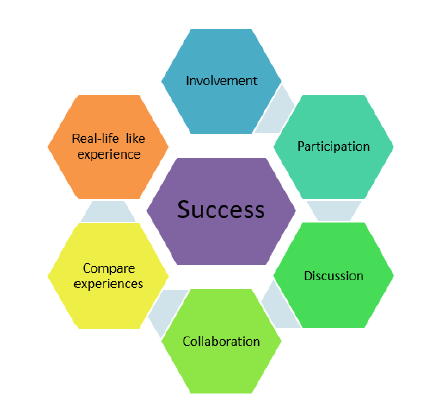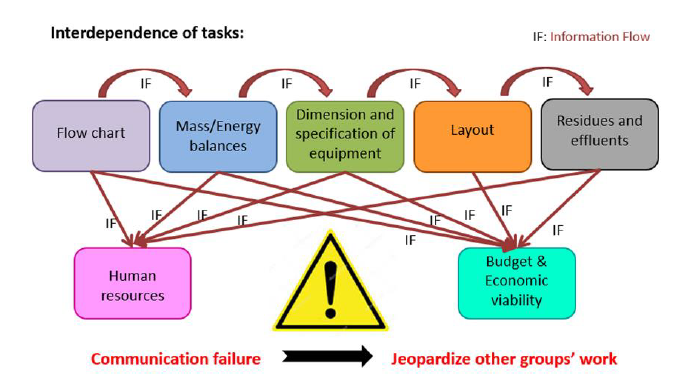Introduction
Collaborative learning comprises a set of teaching/learning methods in which students are stimulated to work together in order to fulfil a common learning goal. This approach has been adopted throughout a very wide variety of disciplines, curricula, school environments, teaching approaches or age groups. The collaborative learning includes on one hand cognitive benefits, such as improved learning performance and motivation, as well as enriched social skills essential for future professional success. Because collaborative learning has been assuming a progressively important role in learning and educational approaches, it has led to a widespread of research devoted to the subject. Collaborative learning relies on the fact that knowledge is a social construct, and the 4 principles of collaborative activities are: 1) The student is primary focus of instruction, 2) Interaction and “doing” are of pivotal importance, 3) Working in groups facilitates learning, 4) Focus on developing solutions to real-life problems. Collaborative learning can occur peer-to-peer or in larger groups. Through peer instruction, students teach each other by addressing misunderstandings and clarifying misconceptions. Group work or collaborative learning can involve a variety of forms, namely, quick active learning activities in class or more complex group projects that span the course of a scholar semester/year (Haataja et al., 2018; Zhang and Cui, 2018).
Regarding the impact of collaborative learning or group work, research has shown that educational experiences which are active, social, contextual, engaging, and student-owned allow students a more efficient learning process. They enhance the development of higher-level thinking, oral communication, self-management, and leadership skills, and at the same time promote student-faculty interaction and prevention of abandon. On the other hand, student self-esteem and responsibility are improved and preparation for real life social and employment situations is enhanced through exposure to increased understanding of diverse perspectives (Järvenoja et al., 2017; Kulikovskikh et al., 2017).
Case method and problem-based learning refer to similar approaches to the teaching-learning process. Both focus the learning experience on realistic or real-life situations, which are undertaken by small groups of students under the guidance of a teacher or tutor. The case method dates from 1870 and was first referred at Harvard University Law School, while problem-based learning was formally presented about one century after, as a derivation from the case method. Problem-Based Learning is a collaborative, student-centred approach to learning in which students learn about a subject by working in groups to solve an open-ended problem. Conceptualising the regulation interactive and dynamic learning is highly influenced by motivational and emotional constraints, because group working experiences and individual socio-emotional aspects are fundamental in determining a group's learning process and cognitive regulation. Strategies that involve students working together to solve a problem include: inquiry based learning, authentic learning and discovery learning. The methodology encompasses the following steps: a) Presenting students with a problem, b) Providing some structure or guidance toward solving the problem, c) Reaching a final outcome or solution (Järvenoja et al., 2017; Servant-Miklos, 2018).
One of the fundamental principles when revising standards for education is curriculum integration, though which theory is deeply linked to real practice, and therefore knowledge is connected, applied, understood and obtainable. The integrated project approach can refer to integrated curriculum or multidisciplinary integration. It is about making connections of diverse nature, including across disciplines, with real life experiences or even skill-based or knowledge-based connections (Mawdsley and Willis, 2018; Mu and Ziolkowska, 2018; Ouko, 2018).
The objective of this work was to discuss the advantages and drawbacks of using innovative learning tools or techniques to promote active learning from a real practice experience. For that, the integrated learning on subjects in area of Food Engineering was analyzed based on the learning outcomes, advances of collaborative work, difficulties found, problem solving strategies and learning assessment limitations.
Methods: case study
As stated before, the main objective of the present work was to develop and implement a multidisciplinary project in the ambit of food engineering learning. For this, a pilot project was planned to correlate the learning objectives of different subjects / curricular units / syllabuses, in a way that would appear natural in terms of the development stages and topics addressed. This would involve a deep curriculum analysis followed by a critical evaluation of the topics to consider and the corresponding suitable timeline. The students considered for the development and implementation of the experimental approach were in the course of Food Engineering, bachelor degree with 3 years’ duration, corresponding to 180 ECTS, and level 6 in the European Qualifications Framework (1st cycle of European Higher Education). Then, they continued their studies in a master degree, with 2 years’ duration, corresponding to 120 ECTS, and level 7 in the European Qualifications Framework (2nd cycle of European Higher Education).
The integrative curriculum approach involved three curricular units, as listed in Table 1.
Table 1 Curricular Units involved in the collaborative integrated project.
| Abbreviation | Curricular Unit | Course | Year / Semester |
| 1-IDFP | Innovation and Development of Food Products | Licence Degree in Food Engineering | 2nd year / 2nd semester |
| 2-IEF | Industrial Equipment and Facilities | Licence Degree in Food Engineering | 3rd year / 1st semester |
| 3-IPC | Instrumentation and Process Control | Master Degree in Food Quality & Technology | 1st year / 1st semester |
The objectives of the integrated project were complimentary between the subjects, as represented in Table 2, and implemented sequentially as the students advanced in the curriculum of the courses involved.
In the implementation of the plan described in Table 2, a critical point was identified associated with the methodology for development of the tasks in phase 2, i.e., the design the industrial plant. In fact, and because all tasks are interdependent, excellent team work and communication must be present at all times for overall success. Hence, failure in one task may compromise other tasks, and therefore will impact the entire project.
Table 2 Implementation of the collaborative integrated project.
| UNIT | 1-IDFP |
|---|---|
| Objective | Phase 1: Develop a new food product |
| Tasks | Generate ideas / Discuss and select a class project / Test formulations / Develop prototypes / Sensory analysis / FQ analyses / Consumer acceptance study / SWOT analysis / Package and marketing considerations |
| Methodology | Involvement of all class, divided in groups. Each group develops its own prototype under the same product category. |
| UNIT | 2-IEF |
| Objective | Phase 2: Design the industrial plant for the production of the product developed |
| Tasks | Define the flow chart of the production line / Make mass and energy balances / Dimension and specification of equipment / Layout / Residues and effluents handling or treatment / Human resources / Budget and economic viability analysis |
| Methodology | Given the amount of work involved and complexity of the tasks, the class was divided into groups, each devoted to a specific task. |
| UNIT | 3-IPC |
| Objective | Phase 3: Specify all instrumentation needed for the factory projected |
| Tasks | Define the flow chart of the production line / Make mass and energy balances / Dimension and specification of equipment / Layout / Residues and effluents handling or treatment / Human resources / Budget and economic viability analysis |
| Methodology | Involvement of all class, divided in groups to analyse the same problem and compare experiences, doing parallel work. |
Results and discussion
The results of the implementation of the collaborative integrate project in food engineering were connected to the learning outcomes in all the subjects involved. Successful learning outcomes were verified at many levels during implementation of phases 1 and 3 of the project (Figure 1), i.e., the development of the product and the specification of the instrumentation needed for the industrial plant.

Figure 1 Successful learning outcomes derived from the implementation of the integrated collaborative project.
In particular, the students were highly involved in the activities planned and actively participated collaborating with each other. The generation of ideas and the brainstorming that followed with ample discussion allowed the verification of the positive as well as negative aspects linked to each of the ideas, and led to a better decision making, in view of approximating the fictional project with real life cases.
However, in phase 3, corresponding to the design of the industrial plant for the production of the product developed, the high risk associated with the critical point identified (Figure 2) originated some problems, namely:
Failure of only one group could be disastrous for the whole project: the group that was aimed at protecting the equipment was much delayed and it brought problems to the group that was working on the layout, who needed the information about the equipment;
Failure in the test leads to unprepared professionals: this was a test made in the context of academic work, but it revealed some unprepared students, who in the future may not succeed in the working competitive environment;
In real life situations failure to work in collaborative teams can lead to dismissal of the employer and put the enterprise at risk: the preparation intended with the collaborative integrated project could prepare the students for the real life situations, but for some it did not seem important enough to get their commitment with the project as a whole;
The lack of responsibility of just a few compromises the assessment of the whole class: because some elements failed in their tasks, the whole objective was not achieved at the end of the semester and that would be reflected in the marks given to the students.
The results obtained with this implementation revealed that the students were not prepared for the experience tested at that time. Hence, because there were still some students who were immature and did not really make an effort to work, alternative measures had to be implemented not to impair the just evaluation of the colleagues.
The encountered alternative solution involved the reduction of level of interdependence between the groups, so that a final outcome could be reached even if some students failed to fulfil their attributed tasks, by allowing alternative assignments. Hence the methodology was as follows:
Divide the class into only 2 groups with a higher number of members
Each group has to undertake all the 7 tasks
The internal division of tasks is the group’s responsibility
The advantages of this alternative way of completing the tasks underlying the integrated collaborative project on food engineering are the following:
In each group, if one task is assigned to one member who fails, it is their own responsibility to solve the problem the best they can, but they always have an “alternative”
Each group depends only on itself to successfully achieve the outcomes
Each of the groups work in parallel, so they can exchange experiences between them
Both groups can benefit from extra knowledge by exchanging experiences
This methodology allows the same level of interactive learning and collaborative work, but avoiding the critical points identified and that proved to lead to eventual failure in the fulfillment of the assigned tasks.
Conclusions
The experience from the present study case allowed some conclusions, as highlighted bellow:
The integrated project in the 3 different syllabus is beneficial and the students tend to engage in the requested activities with true commitment
This approach allows the development of complementary competences and far beyond simple knowledge
It prepares the students for real life experiences, while guarantying a fair evaluation of learning outcomes for all while still at university
Acknowledgements
This work was presented at the ICALE 2018 - International Conference on Active Learning and Education (in collaboration /cooperation with the Flipped Learning Global Initiative), that took place in Viseu, at Instituto Politécnico de Viseu, from 26th to 27th September 2018.
The authors thank Instituto Politécnico de Viseu/CI&DETS and FCT - Fundação para a Ciência e Tecnologia, I.P., for financial support under the project UID/Multi/04016/2016















